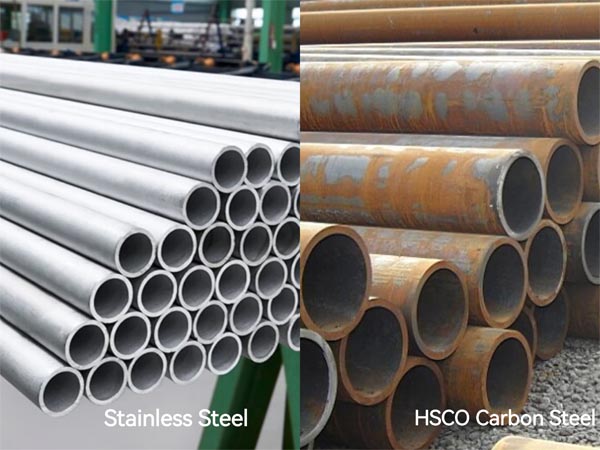The main sign of the difference between
carbon steel seamless pipes (cs pipe) and
stainless steel seamless pipes (ss pipe) is that carbon steel seamless pipes do not artificially add other alloying elements except for the carbon content. Carbon steel seamless pipes generally do not have any corrosion resistance, and their hardness is greater than that of pure iron, but of course it is controlled to a certain extent.
Stainless steel:
The chromium content in steel is more than 13%, and the steel with high resistance to external medium (acid, alkali salt) corrosion is called stainless steel seamless pipe. There are many types of stainless steel seamless pipes, including austenitic stainless steel seamless pipes, ferritic stainless steel seamless pipes, and martensitic stainless steel seamless pipes. Stainless steel seamless pipes are generally not magnetic, but they are not completely correct. Austenite is not magnetic, but ferrite is, but it is relatively weak. Different stainless steel seamless pipes have different ability to resist corrosion, and also have different corrosion resistance to different media.
Corrosion resistance. In practical applications, stainless steel seamless pipes have an irreplaceable role for other steel types due to their excellent various properties. Materials, as well as the excellent mechanical properties of stainless steel seamless pipes make them used in various manufacturing industries.

Carbon steel:
Carbon steel is a kind of steel with a carbon content higher than 0.02% and lower than 2%, and very few other elements. It is also the metal material with the highest output. Steel with relatively high other components (excluding impurities) is called alloy steel. According to the level of carbon content, it is divided into low carbon steel seamless pipe (
mild steel seamless pipe) , medium carbon steel seamless pipe and cast iron. Generally, those with a carbon content of less than 0.2% are called low-carbon steel seamless pipes, commonly known as wrought iron or pure iron; those with a carbon content of 0.2-1.7% are called steel; those with a content of more than 1.7% are called pig iron.
It is usually used on metal parts that require strength, hardness and wear resistance, such as cutting tools, steel cables, piano wires, springs and knives. After machining, the parts usually need to be processed and tempered. The higher the carbon content of steel, the higher its hardness, strength and wear resistance after heat treatment. Carbon steel is divided into high-carbon steel, medium-carbon steel and low-carbon steel, and each of the three types of carbon steel is divided into two types; according to characteristics, high-carbon steel is hard and brittle, and low-carbon steel is soft and ductile.
1. High-carbon steel with a carbon content of 0.6% to 2% is called high-carbon steel. High-carbon steel refers to steel with a long tempering time and high carbon content. Its main uses are general bearings, knives, rails, steel frame molds (used to shape steel) and steel doors.
2. Medium-carbon steel with a carbon content of 0.3% to 0.6% is called medium-carbon steel. Medium-carbon steel refers to steel with shorter tempering time than carbon steel, moderate carbon content, and properties between high-carbon steel and low-carbon steel. The main purpose is to manufacture stainless steel.
3. Low-carbon steel with a carbon content of 0.02% to 0.3% is called low-carbon steel. Low-carbon steel Carbon steel with a short tempering time, soft, stamping-resistant and ductile, mainly used for manufacturing steel bars, stamping-resistant parts, special steel, etc. The main purpose is to manufacture steel bars, casting materials, construction steel products, steel plates, etc.
The difference between stainless steel seamless pipe and carbon steel seamless pipe mainly refers to the difference in design rules between stainless steel and carbon steel, that is to say, the design rules of these two steels are not universal. These differences are summarized as follows:
The design rules for stainless steel cannot be used for carbon steel because there are three fundamental differences between stainless steel and carbon steel:
1. Stainless steel produces work hardening during cold working, for example, it is anisotropic when bent, that is, the transverse and longitudinal properties are different. The increased strength from cold working can be utilized, but if the bending area is small compared to the total area and this increase is neglected, the increased strength can improve the safety factor to a certain extent.
2. The shape of the stress/strain curve is different. The elastic limit of stainless steel is about 50% of the yield stress. As far as the minimum value specified in the standard is concerned, the yield stress value is lower than that of medium carbon steel.
3. Stainless steel has no yield point, and it is usually represented by ≥0.2. The yield stress is considered to be an equivalent value.
Go here to learn more about " Manufacturing Process of Stainless Steel Seamless Pipe"


